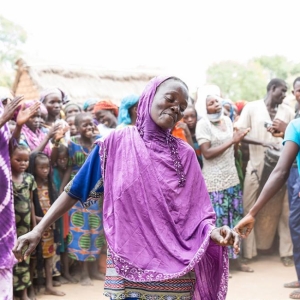
Indicators in this domain assess the extent to which migrants have the same status as citizens in terms of access to basic social services such as health, education, and social security. It also describes the rights of migrants to family reunification, to work, and to residency and citizenship. The ratification of the main international conventions is also included within this domain.
Indicators in this category look at the extent to which migrants have access to certain social services such as health, education and social security. They also examine measures to ensure integration and access to work.
Indicators in this domain assess countries’ institutional, legal, and regulatory frameworks related to migration policies. Domain 2 also reviews the existence of national migration strategies that are in-line with development, as well as institutional transparency and coherence in relation to migration management. This domain also investigates the extent to which governments collect and use migration data.
Indicators in this category assess the institutional frameworks of cities for migration. This area also examines the existence of migration strategies consistent with development objectives, as well as institutional transparency and coherence in migration management.
This domain focuses on countries’ efforts to cooperate on migration-related issues with other states and with relevant non-governmental actors, including civil society organizations and the private sector. Cooperation can lead to improvements in governance by aligning and raising standards, increasing dialogue and providing structures to overcome challenges.
Indicators in this category focus on cities’ efforts to cooperate on migration issues with the national government as well as other cities and relevant non-governmental actors, including civil society organizations and the private sector.
This domain includes indicators on countries’ policies for managing the socioeconomic well-being of migrants, through aspects such as the recognition of migrants’ educational and professional qualifications, provisions regulating student migration and the existence of bilateral labour agreements between countries. Indicators equally focus on policies and strategies related to diaspora engagement and migrant remittances.
Indicators in this category assess cities’ initiatives in terms of international student mobility, access to the labour market and decent working conditions for migrant workers. Aspects related to diaspora engagement and migrant remittances are also included in this domain.
This domain studies the type and level of preparedness of countries when they are faced with mobility dimensions of crises, linked to either disasters, the environment and/or conflict. The questions are used to identify the processes in place for nationals and non-nationals both during and after disasters, including whether humanitarian assistance is equally available to migrants as it is to citizens.
Indicators in this category examine the type and level of readiness of cities to deal with aspects of mobility crises. The questions focus on the processes in place for citizens and non-citizens both during and after disasters, especially if humanitarian assistance is available for migrants and citizens.
This domain analyses countries’ approach to migration management in terms of border control and enforcement policies, admission criteria for migrants, preparedness and resilience in the case of significant and unexpected migration flows, as well as the fight against trafficking in human beings and smuggling of migrants. It also assesses efforts and incentives to help integrate returning citizens.
Indicators in this category look at the cities’ approaches to migrant safety as well as return and reintegration policies and the fight against trafficking in persons.
This country profile describes examples of well-developed areas of the Republic of Colombia’s (hereafter referred to as Colombia) migration governance structures and areas with potential for further development, as evaluated by the six domains of the Migration Governance Indicators (MGI). These address migrants’ rights, a “whole-of-government” approach, partnerships, socioeconomic well-being of migrants, the mobility dimensions of crises, and safe and orderly migration.
Click the icons on the wheel to explore the key findings.
The Migration Governance Indicators (MGI) initiative is a policy-benchmarking programme led by the International Organization for Migration (IOM) and implemented with the support of the Economist Intelligence Unit. Funding is provided by the Government of Sweden.
Migration Governance: Examples of well-developed areas:
-
Regular migrants may access public health services on the same terms as Colombian citizens.
-
Public education is accessible and free of cost to all children in the country up to the secondary level.
-
All persons with a regular status in the country are entitled to work, but must have a work permit issued in accordance with Resolution 6045 of 2017.
-
Migrants in possession of an M visa may apply for an R visa (resident) after five years of uninterrupted residence in Colombia; persons who are Latin American or Caribbean by birth may apply for Colombian nationality if they have remained in the country for a period of one year, or two years if the person is Spaniard by birth.
-
Family reunification is possible for all migrants with a resident visa and migrant visa, and for holders of a visitor visa under certain conditions.
Migration Governance: Examples of well-developed areas:
-
Colombia has a solid institutional framework for migration management.
-
The Ministry of Foreign Affairs (Foreign Ministry) is responsible for formulating and implementing migration policy, while the Special Colombia Migration Administrative Unit is responsible for overseeing and controlling migration. The Labour Migration Policy Management Group, under the Ministry of Labour, is charged with formulating, implementing and assessing policies relating to labour migration.
-
The CONPES 3603 Document of 2009 through which the Government approved the Comprehensive Migration Policy (PIM) is the programme document that systematically lays out the guidelines, strategies and actions to assist Colombians abroad and immigrants in Colombia.
-
There are several coordination bodies that reinforce the horizontal coherence of migration policy, including the National Intersectoral Migration Commission, created in 2003, and the National Migration System, created in 2011
Migration Governance: Examples of well-developed areas:
-
Colombia participates in various regional consultation processes on migration, aimed at migration policy cooperation, such as the South American Conference on Migration, the Ibero-American Network of Migration Authorities, and the Latin American Forum on Migration and Development.
-
Colombia is an associate member of Mercosur, a regional integration process that includes human mobility. Through the Agreement on Residence for Nationals of the States Parties of Mercosur, citizens of Argentina, Brazil, Paraguay, Uruguay, Bolivia, Chile, Peru and Ecuador may obtain temporary residence for a period of two years, after which they may apply for permanent residence.
-
The Government of Colombia maintains bilateral agreements with other countries to facilitate migration management.
-
Colombia involves civil society, the private sector and diaspora organizations in the development of initiatives related to migration. A "National Civil Society Committee " as an initiative under the Foreign Ministry's Colombia Nos Une (Colombia Unites Us) programme, facilitates spaces for participation in the strengthening of the Colombian migration policy.
Migration Governance: Examples of well-developed areas:
-
There are processes in Colombia for monitoring the labour market, the demand for immigrants and for ensuring the ethical treatment of migrants.
-
The Labour Migration Policy Management Group, within the Ministry of Labour, is responsible for following up on offers of employment for immigrants in the country or Colombian nationals abroad, jointly with the National Training Service (SENA).
-
Another function of this Group is to develop mechanisms for the proper treatment of migrant workers. To that end, orientation booklets have been produced for Colombians residing in Spain, Chile, the United States, Peru and Mexico, containing information on their rights as well as options for returning to work in Colombia.
-
As indicated in Article 9 of Resolution 6045 of 2017, immigrants in possession of any kind of visa that is valid for 180 days or longer may pursue studies during the authorized period of stay.
Areas with potential for further development:
-
Colombia recently began assessing the impact of labour migration. Nevertheless, there are still no estimates that provide an up-to-date picture of the situation in the country.
-
The development of formal programs that promote remittances as a source of income could be considered.
Migration Governance: Examples of well-developed areas:
-
The Government has a disaster management strategy that contains provisions on displacements in crisis situations. The National Disaster Risk Management Policy sets forth the different actions to be taken in the event of displacements and other impacts stemming from nature and climate change.
-
Colombia has strategies for managing migration movements triggered by climate change. The National Climate Change Adaptation Plan prioritizes the identification of precarious settlements located in risk areas and which could be affected by the increased frequency of extreme events.
-
The immigration process in Colombia allows for exceptions to facilitate immigration for persons whose country of origin is in crisis. The visitor visa (type V) and migrant visa (type M) afford immigrants the possibility of entering and remaining in Colombia as refugees.
Areas with potential for further development:
-
The disaster management strategy laid down in the National Disaster Risk Management Plan does not include migration-related provisions in respect of crisis prevention and preparedness.
Migration Governance: Examples of well-developed areas:
-
The Special Colombia Migration Administrative Unit assumes the overall responsibility for border control and security.
-
Colombian visa applications can be effected entirely online. The online visa system is available 24 hours a day, 7 days a week, and may be accessed from anywhere in the world.
-
There are several government programmes that focus on facilitating the reintegration of migrants returning to the country. For example, the programs of the Foreign Ministry “Colombia Nos Une” (Colombia unites us) and “Plan Retorno” offer support programes for returnees to the country, including issues of labour reintegration and support for entrepreneurship.
-
The regulatory framework against the trafficking in persons is based on the National comprehensive Strategy to Combat Trafficking in Persons, which currently covers the period of 2016-2018. The Ministry of Home Affairs undertakes coordination and streamlining in this regard and publishes statistics on the fight against trafficking.




